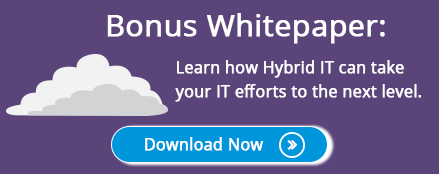 As enterprises continue to find their way in this digital era, the function of the IT organization is changing to take on a leadership role in digital transformation. As a result, technology investment decisions are now driven by strategic vision as well as tactical goals.
As enterprises continue to find their way in this digital era, the function of the IT organization is changing to take on a leadership role in digital transformation. As a result, technology investment decisions are now driven by strategic vision as well as tactical goals.
Why hybrid IT?
In a recent survey of IT decision makers by Frost and Sullivan, top drivers to the adoption of a hybrid IT environment are both tactical (cost reduction and managing data growth) and strategic (supporting business goals and innovation). The hybrid environment, made up of a flexible choice of infrastructure, enables IT to realize critical business goals while redeploying technical assets and budgets toward more strategic initiatives.
Hybrid IT can facilitate achievement of enterprise goals in several ways:
- Enterprises can deploy each workload in the optimal environment, meeting needs for application performance, security and compliance, speed to deploy, and costs.
- Workloads deployed in one environment can be backed up in another environment, supporting business needs for availability and compliance.
- Workloads can even be split among environments so that performance, security and compliance, and speed can be handled optimally.
Five tips for implementing a successful hybrid IT strategy
The benefits of a well-executed hybrid model far outweighs the challenges. To facilitate your enterprise’s transition to a hybrid IT, here are five tips from Frost & Sullivan.
Tip #1 – Collaborate with line of business (LoB) in a “service broker” model for app deployment
The days are long gone when IT took requirements from LoB colleagues and unilaterally chose a deployment model. Today, LoB and IT must work together to ensure applications are deployed and maintained optimally to achieve enterprise goals for agility, innovation, security, and even revenue attainment.
We Recommend: Start or continue your hybrid IT journey by working with LoB to develop new processes for collaboration. Enlist your customer service team to train IT in techniques that will help them build communication skills and ensure all IT employees understand the key business goals and challenges facing your enterprise.
Tip #2 – Jettison your “cloud-first” approach for new applications in favor of a full workload assessment
When the public cloud first appeared on the market, many IT organizations adopted a “cloud-first” approach to deploying new apps on the assumption that it was the easiest and least expensive option. That policy continues for many enterprises today, despite evidence that public cloud is actually sub-optimal for data-intensive, high-performance, or steady-state applications.
We Recommend: Develop a checklist that includes various workload characteristics and can be impacted by where they’re deployed. Have LoB help you assess the workloads and evaluate the characteristics in terms of value and risk to the enterprise. For example, instead of labeling an application as “transaction-intense,” look at it through the lens of the consumer who may leave your site for a competitor’s page if the workload is too slow.
Tip #3 – Bring the cloud to your on-premises data center through strategic investments
Some believe that hybrid IT is “two tiered” where only the newer applications benefit from innovative and next generation technologies. But for many enterprises, legacy workloads like ERP, HR, and databases fall into the second “on premises” tier, and are at risk of being treated like a second-class application.
We Recommend: As it ages, upgrade your on-premises server infrastructure to next generation systems and solutions that will bring cloud-like benefits directly to your organization; this includes hyperconverged infrastructure, flash storage, and software-defined solutions. Measure and report the improvement for a quick and early win that will drive momentum for your hybrid IT strategy.
Tip #4 – Choose a flexible, comprehensive hybrid IT management platform
In the coming years you can assume your workloads will need to work faster and harder, incorporating more intelligence and analytics, drawing from more data of more types, and integrating with third-party apps and microservices. You need to ensure that they continue to operate optimally, which calls for common visibility and reporting across your environment.
We Recommend: Choose a platform that supports both what you need today, and what you are likely to need in the future. It should allow you to manage multiple cloud and data center options, offer support for dev/ops processes, provide a universal API, and include built-in analytics capability.
Tip #5 – Work with an expert partner
Transforming IT while running the business can be a daunting task. Can your enterprise benefit from the quick and assured success that the right partner can bring to the project? A comprehensive business case that quantifies the total company value associated with an optimal hybrid cloud implementation can provide guidance.
We Recommend: Choose a partner with the following:
- Experience in all deployment options, including on-premises infrastructure and public cloud
- A proven methodology supported by best practices
- A range of managed and professional services
- The ability to measure and assess the success of the implementation project, as well as the success of your hybrid IT strategy
Let WEI help you implement your hybrid IT strategy
If you would like more information about how WEI can help with your hybrid IT strategy, please contact us.
NEXT STEPS: Learn more about the benefits of hybrid IT and how to align your business strategy with emerging technology in our white paper, An Introduction to the New IT Approach Called Hybrid IT. Click below to access the white paper.












